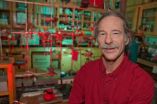(Press-News.org) BOSTON, MA—According to the United States Census Bureau, approximately one in seven American adults live alone. Social isolation and lack of social support have been linked to poor health outcomes. Now a new study at Brigham and Women's Hospital (BWH) shows that living alone may be a risk factor for death, especially death due to cardiovascular problems, such as heart attack and stroke.
The study is the first to prospectively compare the cardiovascular risk of living alone in an international outpatient population. It will be published online in Archives of Internal Medicine on June 18, 2012.
Jacob A. Udell MD
Researchers analyzed data from 44,573 participants in the international Reduction of Atherothrombosis for Continued Health (REACH) Registry. Participants at risk for or with atherosclerosis (hardening of blood vessels) were followed for up to four years for cardiovascular events.
Of the 44,573 participants, 19 percent (8,594) lived alone. The researchers found that those with atherosclerosis who lived alone had a higher rate of death over four years compared to those who did not live alone, 14.1 percent vs. 11.1 percent, respectively. Death specifically caused by cardiovascular problems was also higher among those living alone, 8.6 percent vs. 6.8 percent, respectively.
Moreover, a person's age influenced mortality risk among those living alone. When looking at participants 45 to 80 years old, those living alone had higher mortality and risk of cardiovascular death compared to those who did not live alone. However, after age 80, living arrangement did not appear to play a role in mortality risk.
"Living alone may be a marker of a stressful situation, such as social isolation due to work or personal reasons, which can influence biological effects on the cardiovascular system," said Jacob Udell, MD, Cardiovascular Division, BWH Department of Medicine, and lead study investigator. "Also, patients who live alone may delay seeking medical attention for concerning symptoms, which can increase their risk of dying from a heart attack or stroke."
The study serves to encourage doctors to ask patients with cardiovascular disease if they live alone. It also emphasizes the need for people to seek immediate medical attention for concerning symptoms.
###
This research was supported by Sanofi Aventis, Bristol-Myers Squibb, Waksman Foundation (Tokyo, Japan), Canadian Institutes for Health Research, and Canadian Foundation for Women's Health.
Living alone puts people with heart problems at risk for death
2012-06-19
ELSE PRESS RELEASES FROM THIS DATE:
Alzheimer’s patients experience adverse outcomes, delirium
2012-06-19
BOSTON -- The state of acute confusion and disorientation known as delirium can stem from a serious illness, surgery or infection, and often develops while patients are in the hospital. Now a new study confirms that for patients with Alzheimer's disease, hospitalization and delirium pose a particular risk and can lead to adverse outcomes, including hastened cognitive decline, institutionalization and death.
Led by researchers at Harvard Medical School affiliates Hebrew SeniorLife and Beth Israel Deaconess Medical Center (BIDMC), the study appears in the June 19 on-line ...
Weight-loss surgery increases alcohol use disorders over time
2012-06-19
Adults who had a common bariatric surgery to lose weight had a significantly higher risk of alcohol use disorders (AUD) two years after surgery, according to a study by a National Institutes of Health research consortium.
Researchers investigated alcohol consumption and alcohol use disorders symptoms in 1,945 participants from the NIH-funded Longitudinal Assessment of Bariatric Surgery (LABS), a prospective study of patients undergoing weight-loss surgery at one of 10 hospitals across the United States. Within 30 days before surgery, and again one and two years after ...
Antitoxin strategy may help target other pathogens
2012-06-19
North Grafton, MA, June 14, 2012 -- Researchers have unveiled a novel strategy for neutralizing unwanted molecules and clearing them from the body.
The strategy employs chains of binding agents, like "beads on a string", which target two sites on one or more pathogenic molecules to neutralize their activity and promote their clearance by the body's immune system. The low-cost, easy-to-replicate tool has demonstrated applications against several different toxins, from those found in contaminated food to those used in bioterrorism, and may also prove effective in targeting ...
Highways of the brain: High-cost and high-capacity
2012-06-19
BLOOMINGTON, Ind. -- A new study proposes a communication routing strategy for the brain that mimics the American highway system, with the bulk of the traffic leaving the local and feeder neural pathways to spend as much time as possible on the longer, higher-capacity passages through an influential network of hubs, the so-called rich club.
The study, published this week online in the Early Edition of the Proceedings of the National Academy of Sciences, involves researchers from Indiana University and the University Medical Center Utrecht in the Netherlands and advances ...
Study: Seeping Arctic methane has serious implications for Florida coastline
2012-06-19
The ancient reserves of methane gas seeping from the melting Arctic ice cap told Jeff Chanton and fellow researchers what they already knew: As the permafrost thaws, there is a release of methane, a powerful greenhouse gas that causes climate warming.
The trick was figuring out how much, said Chanton, the John W. Winchester Professor of Oceanography at Florida State University.
The four-member team — whose findings were published in the respected journal Nature Geoscience (http://www.nature.com/ngeo/journal/vaop/ncurrent/abs/ngeo1480.html) — documented a large number ...
Bioinformatics experts at the CNIO explore additional coding potential hidden in the human genome
2012-06-19
Sequencing the human genome was just the first step. The next challenge is of the kind that makes history: to decode the genome, and understand how the information needed to construct a human being can be packaged into a single molecule. And there are a lot more than loose ends in the way of a solution. A group of bioinformatics experts at the Spanish National Cancer Research Centre (CNIO) in Madrid have published findings which point to still unexplored coding potential within the genome.
The substance responsible is chimeric RNA, formed not from one gene but from fragments ...
Black holes as particle detectors
2012-06-19
This press release is available in German.
Finding new particles usually requires high energies – that is why huge accelerators have been built, which can accelerate particles to almost the speed of light. But there are other creative ways of finding new particles: At the Vienna University of Technology, scientists presented a method to prove the existence of hypothetical "axions". These axions could accumulate around a black hole and extract energy from it. This process could emit gravity waves, which could then be measured.
Axions are hypothetical particles ...
New cerebellar ataxia gene identified in dogs
2012-06-19
Researchers at the University of Helsinki and the Folkhälsan Research Center, Finland, have identified the genetic cause of early-onset progressive cerebellar degeneration the Finnish Hound dog breed. The study, led by Professor Hannes Lohi, revealed a new disease mechanism in cerebellar degeneration. A mutation was identified in the SEL1L gene, which has no previous link to inherited cerebellar ataxias.
This gene find is the first in canine early-onset cerebellar degeneration, and has enabled the development of a genetic test to help eradicate the disease from the breed. ...
Family first – caring within UK Bangladeshi and Pakistani communities
2012-06-19
Over the next 20 years the proportion of older people living within the Bangladeshi and Pakistani communities in the UK will increase significantly. Most expect that their immediate family, particularly female family members, will provide the majority of care for them in their old age, according to new research funded by the Economic and Social Research Council (ESRC).
The research by Professor Christina Victor of Brunel University, found very few, at best five to ten per cent of the older people within these communities who were interviewed received any form of formal ...
Digital revolution bypassing UK education
2012-06-19
Teaching and learning in the 21st century needs to be 'turbo-charged' by educational technology rather than using technologies designed for other purposes, according to a new report developed by the Technology-Enhanced Learning Research Programme (TEL) - a five-year research programme funded jointly by the Economic and Social Research Council and the Engineering and Physical Sciences Research Council.
The report System Upgrade: Realising the vision for UK Education is the work of academics, industry and practitioners from across the UK. They warn that to prosper in the ...



